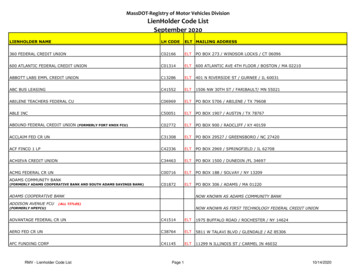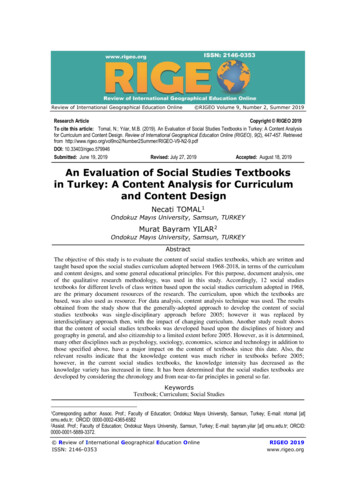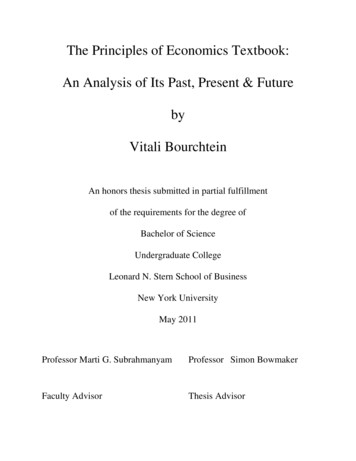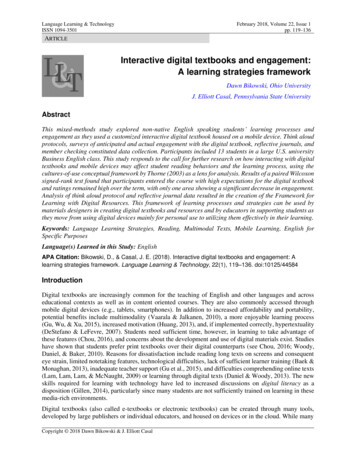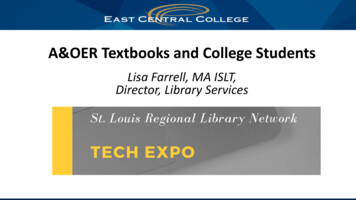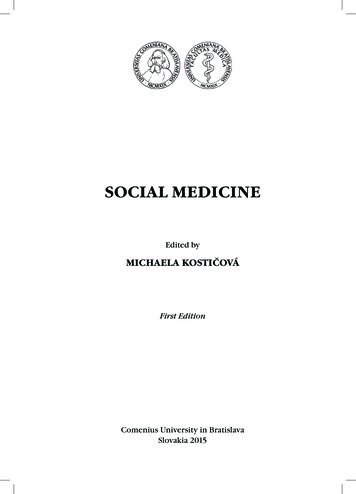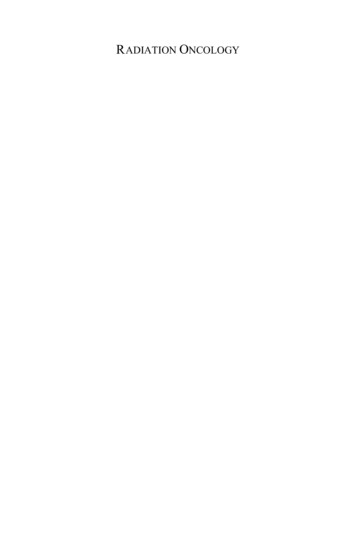
Transcription
ELT-33ELT Textbooks and Materials:Problems in Evaluation andDevelopmentMilestones in ELT
Milestones in ELTThe British Council was established in 1934 and one of our main aimshas always been to promote a wider knowledge of the English language.Over the years we have issued many important publications that haveset the agenda for ELT professionals, often in partnership with otherorganisations and institutions.As part of our 75th anniversary celebrations, we re-launched a selectionof these publications online, and more have now been added in connectionwith our 80th anniversary. Many of the messages and ideas are just asrelevant today as they were when first published. We believe they arealso useful historical sources through which colleagues can see howour profession has developed over the years.ELT Textbooks and Materials: Problems in Evaluationand DevelopmentThis frequently cited 1987 publication focuses on textbooks designedfor use by English language learners, and dictionaries. A range ofauthors explore different theoretical and applied aspects of textbookproduction and evaluation. They discuss teaching materials from variousperspectives, including those of learners, teachers, course designers,editors, reviewers and teacher trainers. The 11 short chapters covertopics such as designing English as a foreign language coursebooks,testing, and criteria for selecting the most suitable materials forparticular learners. Practical guidelines for the evaluation of purpose,content, and design of textbooks are included in the final two sections,along with thoughts on the constraints faced by publishers and thosewishing to adapt materials.
ELT Documents: 126ELT Textbooks andMaterials: Problems inEvaluation andDevelopmentMODERN ENGLISH PUBLICATIONSin association with The British Council
ELT Textbooks and Materials:Problems in Evaluation andDevelopmentELT Document 126Editor: LESLIE E. SHELDON1987 00*00*0*0oo*** 009*90*0*0 00*0Modern English Publications in association with The British Council
AcknowledgementsI would like to thank Oxford University Press for permission to reprintthe extract on page 39 from English in Mechanical Engineering, W. R.Chambers for the excerpts on page 56 from Chambers TwentiethCentury Dictionary and Chambers Universal Learner's Dictionary, andCambridge University Press for permission to quote on page 52 anexercise from Functions of English.LES Modern English Publications 1987All Rights Reserved. No part of this publication may bereproduced, stored in a retrieval system or transmitted in any formor by any means: electronic, electrostatic, magnetic tape,mechanical, photocopying, recording or otherwise, withoutpermission in writing from the copyright holders.Typesetting and makeup by Quadra Associates Ltd, OxfordPrinted in Great Britain by The Eastern Press Ltd., London and ReadingISBN 0 906149 96 7
ContentsI Introduction1LESLIE E. SHELDONII Evaluating MaterialsWhich Materials?: A Consumer's and Designer's Guide13MICHAEL P. BREEN & CHRISTOPHER N. CANDLINNot So Obvious29JOHN DOUGILLWhat's Underneath?: An Interactive View ofMaterials Evaluation37TOM HUTCHINSONCoursebooks and Conversational Skills45ALAN CUNNINGSWORTHA Consumer's Guide to ELT Dictionaries55RICHARD WESTThe Pragmatic Purchaser76MIKE KITTOIII Producing MaterialsPublishers and the Art of the PossiblePETER ZOMBORY-MOLDOVAN85
Learning by Design: Some Design Criteria forEFL Coursebooks90MARK & PRINTHA ELLISThe Evaluation of an ESP Textbook99A. DUDLEY-EVANS & MARTIN BATESIV ADAPTING MATERIALSCurriculum Cobbling: or How Companies Can Take Overand Effectively Use Commercial Materials109JON LECKEYCan Published Materials Be Widely Used for ESP Courses? 119ADRIAN PILBEAMNotes on Contributors125
PrefaceEarly in my teaching career, in Africa, I managed to persuade anumber of publishers to give us a set of new textbooks on the conditionthat we piloted them through a whole school term or year, and sent outdetailed reports, together with copies of the books, to as many schools aspossible. This remains one of the activities with which I am proud tohave been associated. Since then, I have constantly been surprised bythe profession's failure to provide adequate public feedback on teachingmaterials. My first unsuccessful attempt at innovation when I moved tothe London Institute of Education in 1974 was a proposal for a textbookevaluation and monitoring scheme.Consequently, I am delighted that ELT Documents is publishing acollection of papers on materials development, evaluation and adaptation. The kind of information provided on dictionaries in West's paperfollows the successful format of journals and magazines like 'ModernEnglish Teacher' and 'English Language Teaching Journal' and couldbe a basis for a genuine consumers' guide to major textbooks, if only theteaching profession and an enlightened publisher could co-operate.Perhaps teachers' associations like IATEFL and TESOL could set upsomething more consistent than the present random activity.Meanwhile, we owe Leslie Sheldon a debt for collecting papers on allthe major issues in materials development. Written materials arecentral to almost all language teaching, yet they are discussed all toorarely. This collection, full of useful practical advice as it is, is intendedto fill that gap.C. J. BRUMFIT
IntroductionLESLIE E. SHELDONPitman Education and Training LtdFor the purposes of this volume, a 'textbook' may be loosely defined as apublished book, most often produced for commercial gain, whoseexplicit aim is to assist foreign learners of English in improving theirlinguistic knowledge and/or communicative ability. Within this definition are a variety of diverse examples, ranging from books aimed atgeneral English contexts, to those centring upon any one of a number ofspecialist applications. Some try to develop global ability across a widefront, while others focus more narrowly on specific skills. Some areintended for use as central coursebooks over extended periods of time,some for short, intensive revision courses and still others for reference/resource purposes. Most evince an eclectic pedagogical stance, fusinggrammatical, situational, topic and functional components in variousways. Many have peripheral supporting material such as cassettes,video packages, workbooks, teacher's books and, on rare occasions,CALL programs; this collection of essays perceives the textbook to bevery much the centre of the published materials orbit. Methodological,teacher education or Applied Linguistics textbooks are not discussed.It needs to be said at the outset that the relationship between ELTtextbooks and their users is a rather fraught one. Mariani (1980) goesso far as to call it a love/hate affair, which is nothing less in real termsthan 'a sort of compromise through which a temporary armistice hasbeen reached'. Basically, as Swales observes (1980), the textbook is a'problem' evincing a complex of difficulties in its creation, distribution,exploitation and, ultimately, evaluation. Given the fact that textbooksoften claim too much for themselves, for example by purporting to besuitable for all students at all levels, the dashing of expectations at thechalkface is inevitable. The result has been a 'coursebook credibilitygap' (Greenall 1984) of long standing, in which the textbook becomessomething to be endured rather than enjoyed or used effectively. Ofcourse, as Allwright observes (1981): 'The whole business of themanagement of language learning is far too complex to be satisfactorilycatered for by a pre-packaged set of decisions embodied in teachingmaterials'. Quite simply, even with the best intentions no singletextbook can possibly work in all situations. As teachers know well,published materials must be used with caution, and must frequently be
Leslie E. Skeletonsupplemented by homegrown work produced in reaction to the perceived deficiencies of the commerical product.Though it is nevertheless true, for the most part, that 'Books are goodvalue for money' (O'Neill 1982), especially when compared with thesheer labour-intensiveness and expense of teacher-produced materials,this value is still not being maximized for many teachers throughoutthe world. Most do not practise their craft in affluent, unconstrainedenvironments, and the need for non-indulgent, pertinent EFL textbooks that are easily adaptable remains very acute.There is, for whatever reason, a lack of communication between theparties involved in the textbook question. Authors, publishers educational administrators and teachers are often ignorant of one another'strue priorities and constraints. It is one of the purposes of this volume togenerate and focus discussion on such matters. I see this volume ofessays as attempting to collect between single covers, for the first time,a range of diverse, lively perspectives on both the extent of the currenttextbook/materials problem and on possible evaluative solutions whichcould be of direct benefit to the classroom teacher. Indeed, the criterionof practicality must perforce be one of the central yardsticks by whichELT Textbooks and Materials: Problems in Evaluation and Develop ment is judged.The eleven articles by applied linguists, educational purchasers,authors, editors, reviewers, course designers, teachers and teachertrainers, do not offer total comprehensiveness or prescription; but theydo explore many theoretical and applied aspects of textbook productionand assessment which have not been previously considered. In theirturn, these articles should at least provide a cue for further discussionof this neglected and thorny issue.In the main, the contributors focus upon the three critical areas ofEvaluation, Production and Adaptation. Both published and unpublished materials are considered, as there is obviously a vital feedbackrelationship between them: teacher-produced materials often providethe seedbed for the next generation of textbooks. The typical worksheets, cassettes, self-access and grammar units which are intended tosupplement, or even replace textbooks, are clearly related to them.Similar evaluative criteria may be adduced for both types of materialsor, to put it another way, the same kinds of questions can be asked.There would seem to be little profit in Swales' call (1980) for afundamental.division between published and unpublished materials,and a consequent separation of assessment standards.Before considering the specifics of this collection, it is as well toexplore the problematic aspects of the textbook a little further. It wouldseem that the difficulties one would expect are compounded by amultitude of recurring and probably avoidable design flaws, whichhamper the realization of a viable chalkface compromise just as surelyas does the absence of a sustained, coherent professional dialogue onmatters of evaluation.
IntroductionTo name but a few of these difficulties, most textbooks aretantalizingly vague about target learners, especially in regard to thedefinition of entry and exit language levels. One textbook unhelpfullydescribes its putative audience as having a 'high school' level ofEnglish; other books merely use the bald terms 'intermediate','advanced', etc. Since the Council of Europe scales, and the ELTS banddescriptors are readily available and well known, such continuingimprecision makes teacher selection of appropriate textbooks needlessly difficult.Grammatical explanations in some ELT textbooks (as opposed toreference grammars) often take too much terminological and linguisticknowledge for granted. Some ancillary workbooks force students toadopt microscopic handwriting, and are not meant to be worked in atall. Many books have a density of text or diagram which is disconcerting to the hapless learner trying to find his/her way round. Very fewbooks provide linked achievement or progress tests, leaving this vitaltask for the already hard-pressed teacher. Some 'Teacher's Books' areno more than student editions with an inserted answer key.Perhaps more importantly, course rationales, for instance in regardto the introduction and recycling of new lexis, or the grading andselection of reading passages, are rarely explained for the teacher'sbenefit. In many cases such omissions lead one to suspect that there isno real system at all, and that the textbook reflects its classroomorigins by seeming to be a cobbled collection of disjunct one-offs. Thereis almost never any indication of the needs analyses on which aparticular textbook was based, nor of the pre- or post-publication trialsundertaken.The list could go on, and one need only read ELT reviews to discovermore. Whatever one's reservations about the academic rigour displayedin assessments published in the ELT press, they frequently represent adeeply felt, grassroots complaint about the published materials statusquo. From an academic viewpoint as well the textbook is oftenperceived to be a flawed creation, textbook production (particularly inESP) seeming to take place without sufficient regard for the findings oflinguistics research (Ewer & Boys 1981); too often published materialssimply fail to rest upon sound theoretical bases.It is fairly clear, then, that textbooks and their ancillary aids are seenby most consumers as commercial ephemera which are often aggressively marketed, and which necessarily involve a compromise betweenthe pedagogical and the financial. But whatever the teacher's opinionas to the limitations, or indeed the very centrality of the textbook,learners are nevertheless likely to consider it an integral part of theeducational process. Frequently, the seriousness and the validity of acourse will rest upon the selection and faithful application of a relevantclassroom tome. Most learners will evaluate progress in a linear, coverto-cover way, and will probably prefer not to dip into a textbook hereand there or to use selections from a variety of printed sources.
Leslie E. SheldonMoreover, the discrete handouts and photocopies which typify teachergenerated materials have to be 'sold' as valid educational exercises.Many learners feel that the 'sampling' methods which are a corollary ofthe communicative approach evince teacher disorganization and a lackof sure, expert, course direction.In such a situation it does the teacher little good to know that it isunnecessary (and probably unwise) for teaching material to attempteither linguistic completeness or the provision of a relentless instructional ladder (Candlin & Breen 1979), and that his/her reluctance todepend on a textbook might be theoretically valid.All these problems make the whole question of evaluation oftextbooks even more urgent, particularly as their assessment is clearlyrelated to a significant level of chalkface grievance. ChristopherBrumfit (1979) observes ruefully that textbooks do not actually helpteachers most of the time; in addition, There is no Which for textbooks,and masses of rubbish is skillfully marketed'. Though there is still noWhich? to help the consumer steer through such shoals, sporadicattempts have been made to develop teacher-friendly systems forintelligent, rigorous assessment. For instance, various elaborate evaluative questionnaires have been designed, e.g. by Tucker (1975), vanLier (1979) and Williams (1983), with the aim of arriving at meaningful'scores'. These have involved assigning appropriate 'marks' in association with various materials criteria, or merely filling in plus/minusboxes. Such factors as the relationship between the written work setand structures practised orally (Williams 1983), or the adequacy of drillmodel and pattern display (Tucker 1975), can be scrutinized; alternatively, simple questions like 'Is the teacher's book expensive?' (van Lier1979) are asked. Tucker's ingenious scheme actually involves graphicaldisplay of the resulting scores, which can then be compared with an'ideal' textbook curve drawn up by the teacher, the ideal profilereflecting the practicalities of his/her situation. Unfortunately, these andother attempts have not had as wide an audience as they deserve.Coming across appropriate back numbers of ELT periodicals is no easytask in most teaching contexts.The published studies in any case represent only the tip of theiceberg, as all TEFL/TESP training programmes have probablydeveloped their own assessment techniques, many of them extremelysophisticated. A typical scheme would probably make use of a detailedscore sheet which considers, among other things, the nature of theskills bias underpinning a particular coursebook, the scope and utilityof the methodological notes that accompany it and the quality ofassociated aids. A textbook could come in for both an overview and aclose study of the exercises and language tasks set for learners. Thebook could be examined as a language learning tool and as a physicalartefact. Analysis and scoring might be done in pairs, with teachertrainees later comparing notes in a plenary session. The latter couldresult in the formulation of a consensus evaluative summary, which
Introductionmight set out numerical scores and lists of strengths and weaknesses(see also Cunningsworth 1979 and Williams 1981).Alas, many of these good ideas simply do not come to light, andoverworked teachers do not find out about them unless they have bychance taken the appropriate training course, in which case theirlecturers will have devised their own evaluative system and assessment strategies, which may or may not demonstrate an awareness ofwhat others have written or said on the matter. The teacher-traineewill have at best been exposed to a fragmentary picture. Despite thegood work of journals and international and local teachers' associations, ELT is still profoundly isolationist. In sequestered educationalpockets the world over there are enthusiasts busily re-inventing thewheel for themselves. There comes a point at which the diversityinherent in ELT teacher-training and educational practice becomesnothing less than a confusion which impedes professional development.Nowhere is this clearer than in the inchoate state of affairs surrounding the development and evaluation of textbooks.Generally speaking, I think that evaluative questioning of whateverilk clusters round a tripartite framework which considers textbooksand their peripherals in terms of input, throughput and outputelements. In looking at input, for example, we would be consideringsuch issues as the type of user for whom the materials are explicitlyintended, as well as the assumptions made about the constraintsoperating in the target teaching situations. A book and an accompanying cassette package could thus be assessed as suitable or otherwise onthe congruence between these assumptions and reality. Throughputwould refer to the textbook's operation in situ after selection, i.e.whether or not it was acceptable (for both teachers and students),motivating, viable or congenial. In considering Output factors, wewould want to know whether the materials really helped learners toachieve the sort of exit language competence demanded by teachers orby a higher authority. The various parts of this framework are notalways distinguishable; however, what is made clear by such aschema is that evaluation is not only a static, preliminary activity.Like needs analysis, it involves ongoing data collection and fine-tuning.Global statements about the suitability of particular materials can onlybe made after the wisdom of the initial selection is viewed in terms ofhow well things worked in practice, and whether the book provided anadequate link with subsequent materials, textbooks or courses.Frameworks and questionnaires notwithstanding, evaluative techniques cannot provide a foolproof formula by which all materials can beunerringly judged. Indeed, it has been pointed out that the morecomprehensive and telling the assessment strategies, the more likely itis that a perfectly acceptable textbook or set of materials will be foundwanting (Swales 1980). This is not to say that detailed evaluation is afutile exercise, but that it needs to be modified in the light of informedteacher input about the constraints and needs of particular learning
Leslie E. Sheldonsituations. If I may take my cue from John Dougill (this collection),'insights are gained not through answers but by asking the rightquestion'. We can expect no mathematical certainty, but perhaps it ispossible to infer a valid common core of evaluative questioning whichcould be used by a majority of teachers (Sheldon, forthcoming).Textbooks are frequently chosen for such less than edifying reasons asmere availability, but where time and circumstances do permit theexercise of a more reasoned perspective, there should be someconsistency of approach.As a final and perhaps overly optimistic note, it might be worthwhileif discussion and questioning of the sort generated here eventually ledto consideration of the establishment of the very kind of ELT Which?whose absence up till now many have deplored. The quarterly ELTUpdate and the FELCO Book Review represent a valuable first step infilling this gap, but they are both restricted to a small circulation, andare not easy to obtain. Moreover, as is the case with reviews in the ELTpress, the opinions expressed remain fragmentary and subjective,displaying an uneven range of rigour and attention to detail. Something more is surely required. ELT publishing is a multi-million poundbusiness, yet the whole issue of product evaluation and selectionremains lamentably confused. Perhaps it is time for a consortium ofinterested parties to establish a large circulation consumer's guide,which could reflect whatever assessment consensus exists at present. Amaterials Which? would in fact do much to assist the development of aviable consensus in the first place, and would provide a forum for inputfrom all sides of the debate.If such a periodical were not feasible, it might nevertheless bepossible to develop a common criterial grid and scoring system thatcould be used in ELT reviews wherever they appeared (e.g. Fox &Mahood 1982). The purpose would be to provide a core of at-a-glancedata to complement the more traditional textual commentary.Let us now turn to the contributions in this collection.Evaluating materialsMichael Breen and Christopher Candlin provide an interactive, stepby-step consumer's guide which aims to help teachers to make practicaland informed textbook decisions. A set of wide-ranging evaluativequestions is proposed, which examines such matters as the aims andcontent of teaching materials. There is considerable emphasis in thearticle on trying to understand the learner's point of view, anddiscovering judgemental standards that might be used by studentsthemselves.In John Dougill's opinion, the reviewer too must ask tellingquestions, particularly about the characteristics of the target groups atwhich the textbook is aimed, as well as the framework through whichthe linguistic content is communicated. The reviewer's assessments
Introductionneed to be underpinned by a clear rationale as his/her job involves aresponsibility to inform teachers about new books, whilst also beingfair to publishers and authors. It is demonstrated that reviewers arefrequently capable of bias and inconsistency, though the articledescribes a fourfold 'way' which should form the core of the reviewer'sart.Tom Hutchinson's article maintains that practical considerations,such as those revealed by close evaluative questioning about the'surface' of materials, must be treated in concert with theoreticalfactors, especially the implicit assumptions made about the mechanisms of effective language learning. As the latter are rarely spelled outby authors, it is suggested that the teacher needs to pose his/her ownquestions to uncover them. A particular example of how such questioning might be done is demonstrated via detailed analysis of a writingexercise from English in Focus: English in Mechanical Engineering.For Alan Cunningsworth too, textbooks and materials need to beevaluated with reference to linguistic theory, most notably in the areaof Pragmatics. He examines how well a widely used EFL textbookaccords with research findings on the nature of authentic conversational interaction. It is felt that much published material ignores the truenature of oral competence, and presents artificial, stilted dialogues aslinguistic models. In many cases, students are not helped to learn theappropriacy of different utterances in specific circumstances. Cunningsworth's discussion of, for example, turn-taking is intended to helpteachers decide how verbally realistic a set of materials might be.Teachers are not only faced with assessing standard coursebooks andassociated materials. Dictionaries have been increasingly seen as acentral ELT resource, and Richard West gives the reader a detailedanalysis of specific dictionaries, while at the same time presentingcriteria which can be extended and generalized. His results, using aWhich? format, were generated by workshop participants during aseries of UK teacher-training courses.Materials are evaluated not only by teachers and reviewers, but alsoby educational administrators charged with obtaining the best textbook value for money. Mike Kitto examines the financial and practicalpressures exerted on the judgements made by such purchasers who,because of a concern for the maximization of profit and the studentconsumability of textbooks, frequently have priorities at odds withthose of teachers.Producing materialsTextbooks are frequently written from the perspective of specificteaching situations, and the publisher must decide how to effect acompromise between what authors, teachers and accountants wouldlike to see. For teachers, the publisher often seems to move inmysterious, and sometimes exasperating, ways and Peter Zombory-
8Leslie E. SheldonMoldovan outlines some of these, providing insight into how the final,commercial version of a textbook is decided upon. The financial bases oftextbook production are sketched out, and a number of implications foridealistic authors and hopeful consumers are discussed. ZomboryMoldovan sees the teacher's evaluative criteria as not fundamentallyincompatible with these pressures, though his article does considerareas for improvement on the part of the publishing trade.Textbooks are physical artefacts, and the author needs to recognizethat layout, format, typography and graphics are also essential for asuccessful coursebook. Today's textbook consumers have high expectations; it is now widely felt that colourful, motivating and accessiblematerials can legitimately be demanded. Mark and Printha Ellisexplore this aspect of textbooks, and pose objective criteria, such asreading path clarity, which teachers can use to judge the visualeffectiveness of published and, by implication, their own materials.Authors as well, have to take learners into account when designing atextbook, yet in many cases insufficient attention is paid to thebackgrounds and expectations of many overseas target groups.The article written by A. Dudley-Evans and Martin Bates, theauthors of Nucleus: General Science, explores the rather differentproblem of revising a coursebook after it has proven itself in a thirdworld environment for which it was not intended. They discuss thedifficulties in obtaining vital feedback from teachers in Egypt, whereNucleus is used in secondary schools. This case study shows, however,that via such means as questionnaires and seminars, it is possible tostrike up a professional dialogue. Concrete examples of how suchinformation was used to revise the teacher's manual are described.Adapting materialsOften, particularly in ESP, published materials must be modified orused selectively. Course designers have to accept the need to integrateoff-the-shelf and teacher-produced materials in conformity with directions laid down by a client or an employer. Jon Leckey considers thedifferences between training and teaching, and the divergence inselection procedures implied by this distinction. He cites an in-companycase study (which involved selection of a sample from four hundredtextbooks), in which stages of criterial refinement were used to isolatethe most appropriate commercial materials prior to their modificationand supplementation.Finally, Adrian Pilbeam explores more directly the blood relationship between published and unpublished materials, concluding that theseeming attractions of tailor-made materials are outweighed by theflexibility and economy that can be achieved by using textbookswhenever possible. It is suggested that this approach is especially apt inBusiness English, where there seems to be a generous core of languageitems underlying a wide range of jobs and industries. The question of
Introductionwhether or not to use teacher-produced material, and in whatproportions, is answered in terms of criteria such as cost, time,flexibility and appropriacy.ReferencesAbbs, B. (1984) The look of the book, EFL Gazette, 53/54, 15.Allwright, R. L. (1981) What do we want teaching materials for? English LanguageTeaching Journal, 36, 1, 5-18.Bell, R. T. (1981) An Introduction to Applied Linguistics, Batsford Academic.Bloor, M. (1985) Some approaches to the design of reading courses in English as aForeign Language, Reading in a Foreign Language, 3, 1, 341-61.Boisseau, N. (Ed.) ELT Update. English Language Teaching Information Services.Brumfit, C. (1979) Seven last slogans, Modern English Teacher, 7, 1, 30-31.Buckingham, T. (1978) Some basic considerations in the assessment of ESL materials,Mextesol Journal, III, 2, 26-36.Candlin, C. N. and Breen, M. P. (1979) Evaluating and designing language teachingmaterials, Lancaster Practical Papers in English Language Education, 2, 172-216.Cunningsworth, A. (1979) Evaluating course materials, in Teacher Training, Ed. SusanHolden, Modern English Publications, 31-33
for use by English language learners, and dictionaries. A range of authors explore different theoretical and applied aspects of textbook production and evaluation. They discuss teaching materials from various perspectives, including those of learners, teachers, course designers, editors, re
